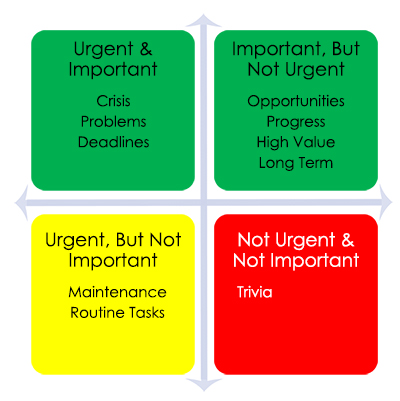Most of us spend more time at work than we do engaged in any other activity other than sleeping. If we consider how much of our lives we spend in our workplace, it quickly becomes clear that spending this time unhappy, unfulfilled, and just counting the days until the weekend is a waste of time and energy. Finding ways to be happier at work can not only lead to better mental health, but can improve your productivity and overall work performance. One key way to cultivate more happiness at work is to plan for it! Develop habits that get your work day off to the right start, and you’ll see greater happiness throughout the day and week.
Have a Nightly Routine
Nothing gets your day off on the wrong foot like rushing around in the morning! Lost keys, skipping breakfast, discovering that the pants you wanted to wear are not back from the dry cleaner – all this can throw your morning into chaos. Taking time the night before to organize what you need for the next day can help avoid this morning rush and let you start your day centered, organized, and with everything you need. Create a nightly routine – and follow it! Choose your clothes for the next day, set up your coffee maker (especially if it has a timer and automatic brew!), and pack your lunch. Take time to place the things you will need for work the next day in your briefcase or bag. You might even choose a space near the door to be your “launch pad,” a space where everything you need for the day is in one place and easy to pick up. Your routine will vary depending on what you need each day, what your workday looks like, and what the needs of your family are. It might even help to make yourself a checklist until the routine truly becomes a habit.
Get at Least 8 Hours of Sleep
Sleep deprivation is bad for your mental, emotional, and physical health. It’s hard to feel productive, happy, and positive when you’re exhausted! Making sure that you get at least 8 hours of quality sleep per night is one step you can take to help prepare yourself to be happier and healthier, both at work and in the rest of your life. Many of us are used to running on just a few hours of sleep, or to getting sleep that isn’t truly restful. There are a few steps you can take to ensure that you get the most restful sleep possible and wake up ready to face the day with a positive attitude.
• Steps to Quality Sleep:
o Go to bed and wake up at the same time every day – including weekends
o Have a nightly routine that prepares you for bed – shower, tooth brushing, prayer or meditation, etc.
o Put away the electronic devices
o Make your bedroom a sanctuary
Wake Up Early Enough for Some “Me” Time
Getting enough sleep is important, but waking up early enough so that you have time to transition into your day can also help foster happiness. If you usually hit the ground running and leave the house with just enough time to make it to the office on time, you are kicking your day off with anxiety. Waking up even 15 minutes earlier so that you can have some “me” time can help you ease into your day with a sense of centeredness instead of a sense of panic. Some people like to wake up very early and have an hour or more of “me” time, while others just need an extra 10 or 15 minutes to linger over a cup of coffee or tea. Figure out what works for you!
• Ways to Use Your “Me” Time:
o Read the newspaper or a passage from a book you are enjoying
o Pray or meditate
o Do some light stretching or yoga
o Linger over your coffee, tea, or breakfast
o Spend time stroking your pet
It’s important not to use your “me” time to get a head start on your work day by reading emails, working on projects, or checking voicemail!
Give Yourself Time to Arrive at Work Early
Commuting is often the most stressful part of the workday. Whether you drive, walk, bike, or take public transit to work, delays and traffic jams can get your day off to a stressful start. Too often we make this worse on ourselves by leaving for work at the last possible moment, meaning there’s no room for error, and that we arrive at work with only moments to spare before we have to jump into our first project or meeting. All this can leave us frazzled, anxious, and short-tempered. Altering your morning commute so that you can arrive 10 to 15 minutes early for work helps you ease into your workday instead of having to throw yourself right in. And giving yourself that cushion can also give you much-needed wiggle room in your commute to account for the unexpected. When you arrive early, you have time to transition gradually into your work — check email, get a cup of coffee, check your schedule and to do list, or simply say good morning to your coworkers. This helps you meet the day in a positive frame of mind.
Plan Your Day
Taking a few minutes to plan your day can help alleviate stress and promote happiness at work. You don’t have to plan every minute, but having a sense of what needs to be done, what expectations need to be met, and what time and resources you’ll need throughout the day can make your workday run much more smoothly.
Arrive 10-15 Minutes Early
Arriving at work early is one simple step you can take to foster your happiness at work. When you arrive early, you have time to think about your day and make a plan, rather than having to immediately start with tasks and meetings. Planning ahead so that you arrive early means that you can get settled into your day by greeting coworkers, checking mail, email, and voicemail, take a look at your calendar, and otherwise get an overall picture of what your day will involve.
Build in Breaks
We all want to be productive at work. While it might at first seem counterintuitive, building breaks into your day can help you be more productive and happier at work. Building short breaks into your day helps to break work into manageable chunks. It also gives you guideposts to aim for – and if you make a break something to look forward to, you may find yourself working more efficiently to get to it. Breaks give you time to reset, relax, and tune in. They also help you as you transition into different projects or other aspects of your work. Build regular breaks into your workday as you create your to-do list – and put those breaks on your list or schedule, just like you would any other appointment! You can use your breaks to check email, take a walk around the office or even get outside for a few moments, get yourself a drink or snack, or even just take a few moments to not think about work. You might build in different types and lengths of breaks as well, or consider having a coworker who is your “break buddy.” Breaks should be long enough to give you time to reset but not so long that you get completely distracted – 5 to 15 minutes is a good guideline, with a lunch or dinner break being longer. Even if you can’t get up from your desk or out of your office, taking a quick 5 minute break can leave you feeling refreshed and recharged.
Relate to Others
Even if we work well independently, it is important to take time to relate to others in the workplace. Building work relationships helps us feel less isolated and creates a support network. Relationships also help us feel part of a team or workplace community, which can promote happiness. When we have strong relationships with our coworkers, we may even look forward to going to work! Instead of being a place where we are disconnected, work can become another place where we connect with others.
Greet Your Colleagues
Something as simple as taking the time to greet your colleagues when you come into the office can make all the difference! Can you remember a time when someone just saying “Hello” improved your day? When we take the time to greet others, we make a connection. It is likely that your colleagues will greet you back, spreading the good feeling. Starting the day with a positive interaction with another human being helps you feel connected and can turn a rough morning into a productive, happy day. You don’t have to stop to have lengthy conversations with every person you meet, but taking the time to smile and wish them a good morning is a worthwhile investment of your time.
Note: This article was originally published in the Houston Business Journal
by Christine R. Spray
Founder & President of Strategic Catalyst, Inc. and the National Business Development Association
Photo: ID 60375662 © Warrengoldswain | Dreamstime.com












